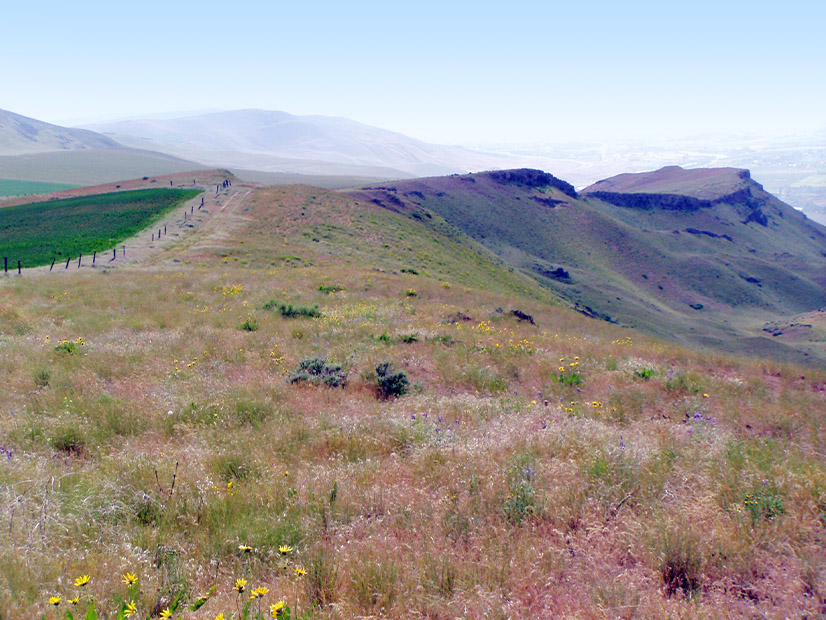
The developer of a large and controversial wind and solar farm in southeastern Washington contends the state’s siting body has ordered unscientific changes that make the project unviable.
Scout Clean Energy, the Colorado-based developer of the proposed Horse Heaven Hills Energy Center, submitted a letter to the Washington Energy Facility Site Evaluation Council (EFSEC) on Jan. 19 that showed the company correctly anticipated how the state board would seek to alter the design of the project during a public meeting Jan. 31.
In the letter, Scout Clean Energy President Michael Rucker said the “ad hoc” changes proposed by EFSEC “are an arbitrary, drastic departure from established council precedent. Further, they are unsupported by scientific or any other evidence in the record and would render the project both technically and economically non-viable without substantial amendment to the application.”
During the Jan. 31 meeting, EFSEC issued a requirement that Scout create a two-mile buffer around each known ferruginous hawk nest within the project’s 112-square-mile site. In 2021, the Washington Fish and Wildlife Commission unanimously heightened the status of ferruginous hawks from “threatened” to “endangered.”
EFSEC also ordered that Scout not locate turbines in areas considered culturally significant to local tribes. The council agreed to the strictest environmental options presented to it by its staff.
Scout’s plans call for either 222 wind turbines up to 500 feet tall or 141, 657-foot turbines along a 24-mile east-west stretch of the Horse Heaven Hills just south of Kennewick. EFSEC’s Jan. 31 decision potentially would cut from the project up to 116 of the shorter turbines or 73 of the taller ones. The exact numbers are imprecise because the developer could shift the locations of some of the removed turbines.
Scout’s proposal also includes two 500-MW solar farms on the east and west sides of the 24-mile stretch. EFSEC ordered that the eastern solar farm be removed because of its proximity to sensitive tribal cultural sites.
EFSEC environmental planner Sean Greene said there are roughly 60 to 70 hawk nests and significant cultural sites within two miles of the turbines to be eliminated.
“It won’t eliminate all the impacts, but there will be a significant reduction in impacts,” EFSEC Chair Kathleen Drew said.
‘Guessing Game’
The project has drawn strong opposition from many Tri-Citians because the turbines would show up in a currently pristine view of the hills from the urban area and because of the proximity to the ferruginous hawk nests. EFSEC staff noted the altered plan would remove turbines from along the north slopes of the hills, eliminating many residents’ concern about their views.
If built, the wind project would be the second in Benton County. Richland-based Energy Northwest, which owns and operates the 1,216-MW Columbia Generating Station nuclear plant north of the area, operates 63 wind turbines several miles southeast of the northern face of the Horse Heaven Hills. Completed in 2007, that site covers about 8 square miles and produces almost 96 MW. It is not visible from the Tri-Cities and has sparked no controversies.
In its Jan. 19 letter, Scout said the changes would trim the nameplate capacity of the wind portion of its project from 1,150 MW to 236 MW.
The letter contested the buffer zones around the hawk nests, arguing most are remnants that no longer are used by the birds.
“The decline of ferruginous hawk in Washington has been primarily the result of foraging habitat loss due to agricultural conversion,” Rucker wrote. “This factor is apparent in the Horse Heaven Hills, where nearly all previously documented nests have less than 30% available foraging habitat within 2 miles. Even before the project was proposed, ferruginous hawks have been essentially eliminated from the Horse Heaven Hills through this landscape-level conversion of habitat and encroachment of residential uses.”
The letter argues that it has been nearly five years since active nests were recorded within two miles of the project.
“No active nests have been documented since then, despite ongoing annual surveys by qualified biologists,” Rucker wrote.
Regarding the buffers around cultural sites, Rucker said, “the implications of this decision for future energy facility siting in Washington State are dire. It suggests that the council could redesign the project and prohibit any portion of a project based on [tribal cultural sites] that are undisclosed to an applicant. … Energy siting in Washington would become a guessing game, one few developers will be willing to play given the substantial at-risk costs involved.”
Wildfire Concerns
Addressing another matter related to the project, EFSEC staff told council members Jan. 31 that airplanes dropping water or flame retardants on range fires must fly within 500 feet above the ground. Consequently, those planes cannot fly over range fires among the wind turbines. EFSEC directed Scout to come up with a plan for fighting fires on its property to compensate for firefighters not being able to use planes.
Southeastern Washington is mostly shrub-steppe and grasslands that are susceptible to fast-moving range fires. Rural fire departments routinely fight those fires with state help, including planes, on the larger fires.
During the meeting, EFSEC also granted Scout’s request that the agency delay its final decision on the project until April 30 to give the company time to regroup and consider its options. EFSEC’s role is to make recommendations to Gov. Jay Inslee, who will issue the final decision on the project.

